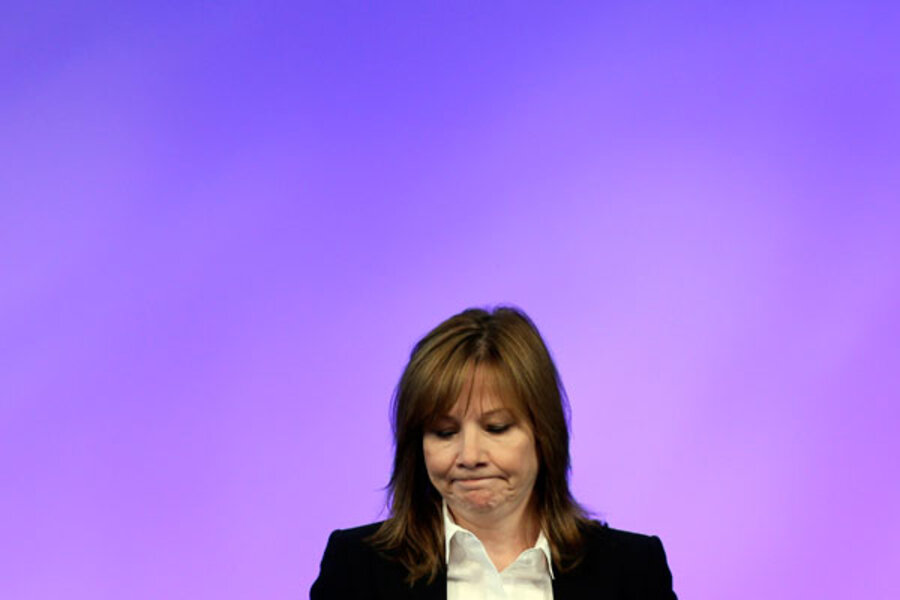'Brutally tough' GM report sheds new light faulty ignition switch
Loading...
General Motors blamed “a pattern of incompetence and neglect” for a global recall crisis that resulted in the deaths of at least 13 people and has resulted in investigations by Congress and the Department of Justice, among others.
The Detroit automaker released an internal investigative report Thursday and fired 15 employees, in addition to disciplining five more linked to the crisis. None of the reprimanded employees are top executives.
The report provides a detailed chronology of how a faulty ignition switch described by an early engineer as “the switch from hell” made it into GM cars – and why it took so long for the company to acknowledge and correct its mistake. Court depositions taken from company engineers last year suggest that the issue dated back to 2004; Thursday's report by former US attorney Anton Valukas pushes the problems back further to 2002.
Even after a redesign, the switch still proved defective but was nonetheless approved for production. The GM engineer named in the report as approving the part, Ray DeGirogio, was among those fired this week.
The ignition defect was well known as problematic considering “GM engineers, customers, and members of the automotive press found repeatedly” that it would power the vehicle down randomly and unexpectedly.
Despite this, the issue was never resolved, the report says, mainly because of the company culture: Engineers flagged the problem as one of customer satisfaction, not public safety.
Company investigations “proceeded slowly and without significant progress,” the report adds. “Throughout the entire 11-year odyssey, there was no demonstrated sense of urgency, right to the very end. The officials overseeing the potential fixes and investigations did not set timetables, and did not demand action.”
Mr. Valukas and his team interviewed more than 230 people connected to the crisis and combed through more than 41 million documents. GM CEO Mary Barra, in prepared remarks to employees Thursday morning, called the report “extremely thorough, brutally tough, and deeply troubling.”
The company has apologized but has not yet admitted liability. The worldwide recall, one of the largest-ever for the company, covers 2.6 million vehicles. To date, the company says it has repaired 113,000 of the vehicles.
GM is promising to fix the problem and has introduced several measures to show it takes safety issues seriously, including more than doubling the number of engineers tasked with examining potential defects.
However, the company remains under intense political pressure. A Department of Justice probe is looking into potential criminal liability. There are also investigations by the federal Securities and Exchange Commission, a group of state attorneys general, and two congressional committees.
GM has established a compensation fund run by disaster-response expert Kenneth Feinberg but has said that it would pay only victims of crashes resulting in injuries or deaths, not all owners of vehicles affected by the recall. The company is also trying to persuade a federal bankruptcy court to shield it from any product liability claims dating before July 10, 2009, when it emerged from bankruptcy.
An analyst for the British bank Barclays suggests that GM might settle for $1.5 billion rather than facing a court battle with victims. Together with a $1 billion federal fine, that could bring costs to $2 billion to $3 billion.
While auto industry analysts generally applaud the company for its comprehensive efforts regarding the recall, lawmakers are more critical.
Rep. Fred Upton (R) of Michigan said in a statement that the findings are “deeply disturbing,” and he suggested “legislative remedies” may be necessary to ensure the company has righted its practices.
Likewise, Sen. Richard Blumenthal (D) of Connecticut called the report “the best report money can buy” because “it absolves upper management, denies deliberate wrongdoing, and dismisses corporate culpability.”
He pushed for the various federal investigations to yield more comprehensive results and criticized the company for not yet setting an amount it plans to pay victims. Senator Blumenthal has urged the company to set aside a fund of between $3 billion and $8 billion for victims.
“This morning’s underwhelming response makes the Feinberg process all the more important to ensure that all victims are both acknowledged and compensated,” he said.








